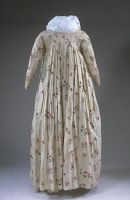 In exploring shapes, patterns, and periods for this gown, I’ve run into a sort of conundrum as to what exactly I want in terms of waist. The robe I love love love is the open robe from Janet Arnold, which is a 1790s style, that lovely transitioning period between Georgian and Regency. Making this robe, however, would require that the waist of the gown underneath be an empire waist, in essence a Regency gown, which I am not all that fond of. The chances of me taking off the feather robe and wearing just the under-gown for dancing and temperature control are high, and I want to look and feel nice in whatever that gown ends up to be. Originally, I wanted to make a chemise dress, with the waist at the natural waist, like Kendra’s, Jenny’s, and Sarah’s. However, it might look a little odd to cross 18th c. decades, and have a waistline and sash sticking out from under the robe.
In exploring shapes, patterns, and periods for this gown, I’ve run into a sort of conundrum as to what exactly I want in terms of waist. The robe I love love love is the open robe from Janet Arnold, which is a 1790s style, that lovely transitioning period between Georgian and Regency. Making this robe, however, would require that the waist of the gown underneath be an empire waist, in essence a Regency gown, which I am not all that fond of. The chances of me taking off the feather robe and wearing just the under-gown for dancing and temperature control are high, and I want to look and feel nice in whatever that gown ends up to be. Originally, I wanted to make a chemise dress, with the waist at the natural waist, like Kendra’s, Jenny’s, and Sarah’s. However, it might look a little odd to cross 18th c. decades, and have a waistline and sash sticking out from under the robe.




 Now here’s a beautiful image, this short-sleeved open robe worn over, again, a higher-than-natural-lower-than-empire waisted chemise gown. This ensable is getting quite a bit closer to how the Barn Owl Gown will look.
Now here’s a beautiful image, this short-sleeved open robe worn over, again, a higher-than-natural-lower-than-empire waisted chemise gown. This ensable is getting quite a bit closer to how the Barn Owl Gown will look.
However, there is still something extremely charming about the first image in this post – the empire-waisted robe with what is essentially a Regency gown beneath. It may come down to a matter of complexity and my willingness to try to drape a pattern or use an existing one. I have a fairly decent Regency gown pattern that I have worked with before and found to be rather pretty and easy. With some adjustments to the front (I want gathers all the way down the front), the back, the sleeves, and the length, it may just be better to go with the high-waisted 1790s transitional look than to attempt to craft something from scratch. I’m having a hard time thinking a between-waistlines gown would be flattering, and I’m reluctant to extend the lines of the regency bodice down a little for that reason. And so I think my mind is made up! Watch for upcoming construction details on the undergown, as it is to be worn for a picnic in mid-June, along with the mockup of the robe, which will be draped from scratch :-).




One Comment
Anonymous
October 9, 2009 at 8:30 AMThose mystery images come from the victoria and albert museum in London. You can browse their archive and order for free home use high resolution copies of them. There's also a book "400 years of fashion" which shows most of their collection.